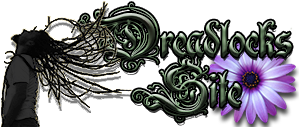My research was relatively quick, and by no means do I consider it whole nor 100% accurate, so if you see anything that is in need of correction, elaboration, addition, omission, or you have any thoughts or opinions or concerns to express at all pretty please don't hesitate to do so!!!
I must start by saying that long before people had combs, people had hair. Therefore, it is safe to assume that EVERYONE wore matted hair at some point!
I'd also like to note a piece of information that I think relates well to the significance of all dreadlocks through all cultural histories and religions. It is an ancient a wide-spread belief in both Both Eastern and Western Traditions that bodily, mental, and spiritual energies mainly exit the body through the top of the head and the hair. If the hair is knotted, the energy remains within the hair and the body, keeping a person more strong and healthy. (THAT'S whats wrong with the world today! COMBS! :D oooh I hope and wish it were that simple!!!)
Dreadlocks have also often symbolized a powerful connection to the Earth and Nature, and later as a connection to celestial deities.
In regards to specific times and cultures, this is what I've found...
Africa
The vast region of Africa and the surrounding areas are considered to be the cradle of civilization (Mesopotamia) It has been populated with various tribes and peoples for thousands of years, most of whom still sport many different dreadlocked styles for tons of different reasons. Warriors, shamans, and women sport them, with different adornments such as beads woven in, mud or clay and ochre mixed and applied to the locks for color and smooth texture, etc etc. Due to the texture and nature of African hair I'd say it's safe to assume the practice of dreadlocks reaches back farther in time than recorded history can tell.
Egypt
One of the oldest and most well- recorded ancient civilizations (3100bc) ancient Egyptians are seen in innumerable statues, sculptures, and bas-reliefs wearing dreadlocks and dreaded or plaited wigs. Archaeologists have unearthed mummies from tombs sporting formed dreadlocks. Pharaohs were believed to be the sons and daughters of Gods, their flesh incarnations, and therefore highly spiritual. Later on, heavily adorned plaits and locks were afforded to the extremely wealthy as well as royalty, becoming more and more a status symbol.
I'll also note here that the Nubian people of ancient Sudan and North and East Africa wore their hair in locks and worked and lived closely with the ancient Egyptians.
India/ Dravidian
Dravidians are believed to be of African origin. Similarities between their complexion, forehead structure and bone structure support this claim. According to experts, this race arrived in India around 3000 B C. According to the Indo-Aryan migration hypothesis, the Aryans, a nomadic people, possibly from Central Asia or northern Iran migrated into the north-west regions of the Indian subcontinent between 2000 BC and 1500 BC.
Their inter-mingling with the earlier Dravidian cultures apparently resulted in classical Indian culture as we know today.
Among some Sadhus and Sadhvis, Indian holy men and women, locks are sacred, considered to be a religious practice and an expression of their disregard for profane vanity, as well as a symbol of their spiritual understanding that physical appearances are unimportant. Locks in India are reserved nearly exclusively for holy people. The public symbol of matted hair is re-created each time an individual goes through these unique experiences.
The Hindu deity Shiva and his followers were described in the scriptures as wearing "jaTaa", meaning "twisted locks of hair", probably derived from the Dravidian word "caTai", which means to twist or to wrap.In almost all myths about Shiva and his flowing locks, there is a continual interplay of extreme asceticism and virile potency.
A good story of Shiva and his dreads: Gangadhara Shiva captures and controls the river Ganges with his locks, whose descent from the heavens would have deluged the world. The river is released through the locks of his hair, which prevents the river from destroying earth.
Celtic/Druid
The Celts were a diverse group of people whose empire once spanned the European continent. Archeological digs from Halstadt, Germany to the Orkney Isles of Scotland have uncovered evidence of Celtic settlements as far back as the late Bronze Age (1550BC-1200BC)
Recent archeological digs in Eastern Europe and Asia Minor indicate the possibility that the Celts were not indigenous to Europe at all. This theory is the migratory theory; when applied the Celtics sometime in the millennia of the Bronze Age entered Europe from somewhere in Asia Minor. It wasnt long before they settled in the region of the Danube River basin and soon began raiding and conquering their neighbors. The Celtic conquest continued until their tribal lands covered most of Western Europe, from the Danube to Rome and westward as far as current-day Belgium.
It is believed that the Druids were the shamans and mystics of the Celts, their dreadlocks holding similar divine significance in their roles as holy people. Some speculate that Celtic warriors sported dreadlocks as an intimidation tactic.
The empire of the Celts had a fast rise, but eventually in the face of Roman domination, they were forced to disperse and/ or assimilate, to Gaul, France, Ireland, Greece, etc. after which they dropped almost entirely off the radar.
Scandinavian Norse/ Vikings
AD793 - 1050 The Vikings were prolific seafaring warriors from Denmark, Norway and Sweden. Vikings also established farming communities and trade ports all over Europe with their rise.
Viking warriors were said to wear their hair in locks, I believe for reasons similar to other locked warriors, for intimidation (or because warriors are just to darn busy to comb their hair!)
Now, these pieces of history lead me to believe that the nomadic "Aryans" from Central Asia/ northern Iran from 2000 BC and 1500 BC later became (or certain tribes became) the people known as the Celts, and because of the lost cultural history of the Celts after Roman domination, the origination of Vikings in Scandinavia, their occupation of the British Isles and Ireland, and similarities between Celtic and Norse mythology, I'm tempted to speculate that Vikings and Celts also share a deep cultural connection lost to time.
*As a side note, while we're on the topic of Ireland and Britain, I'd like to mention Shakespeare's reference to elf locks, or fairy locks, i forget his exact term. The little bit of lore goes that in the night, little elves or fairies tie knots in your hair and it is very bad luck to comb them out  That totally captured my imagination! :D
That totally captured my imagination! :D
Islam
Certain sufi groups such as the Qalandari sects don't cut their hair and don't comb it. This leads to natural formation of dreadlocks. However, some of them will be very thick and others thin or untwisted because the actual making of dreadlocks and giving it a regular look is frowned upon.
Judaism/ Nazarites/ Early Christians
Dreadlocks have a lot of connection to Judaism. Cohens (the priest caste of Judaism) are forbidden to cut their hair or to comb it. They found ways around it - but they are not supposed to pass iron through their hair
The Nazarites take a vow to never cut their hair, and in their vow they dedicate their head to God, popular Nazarites being Samuel, John the Baptist, and Samson. The tale of Samson and Delilah in which a mans potency is directly linked to the seven locks on his head (the biblical Sampson wore his hair in dreadlocks, and his unsurpassed strength was lost when Delilah cut off his seven locks of hair.)
The very earliest Christians also may have worn this hairstyle. Particularly noteworthy are descriptions of James the Just, first Bishop of Jerusalem, who wore them to his ankles.
Ethiopia/ Rastafari
The Kebra Negast, or the Glory of Kings, is considered sacred not only by Orthodox Ethiopian Christians, who comprise 65% of the country's population, but many Jamaican Rastafarians who believe it predicts the last Ethiopian King was God incarnate (Emperor Haile Selassie, "Power of the Trinity," born Tafari Makonnen, was Ethiopia's regent from 1916 to 1930 and Emperor of Ethiopia from 1930 to 1974). It documents the lineage of the Ethiopian monarchs, who are said to descend directly from Menelik, son of the Israelite King Solomon and the Ethiopian Queen Makeda. It also tells the story of how the Ark of the Covenant was taken from Israel to Ethiopia, and how the Ethiopians became God's new chosen people.
Interestingly, it would appear that before the Diaspora, Jews used Cannabis as a sacred herb. It was known as Kne Bosem - translated loosely as aromatic cane, and was a regular part of worship.
Generally, Rastafari people believe that they are the original Lost Tribes of Israel that were once scattered by Babylon.
The similarities between the Zion of the people of Israel and the Rastifari Zion of Africa/ Ethiopia and the connection between Ethiopia and Judaism leads me to believe that the significance of dreadlocks held by the Nazarite people are deeply linked to the Rastafari tradition of dreadlocks (the locks are said to be from Jah, and some scientists also speculate that Jah as another word for Jehova)
Other dreadlocked tribes that I'm lacking much information on are The Maori people of New Zealand, Dervishes of Islam, The Greeks, the Pacific Ocean peoples, the Naga people, and the Aztec priesthood.
That's pretty much all I've got! :D I can't wait to see what knowledge and ideas people have to share here! Thanks!
xoxox
updated by @ocallaghan: 02/14/15 03:18:36AM




 Thank you for the info!!!
Thank you for the info!!!


